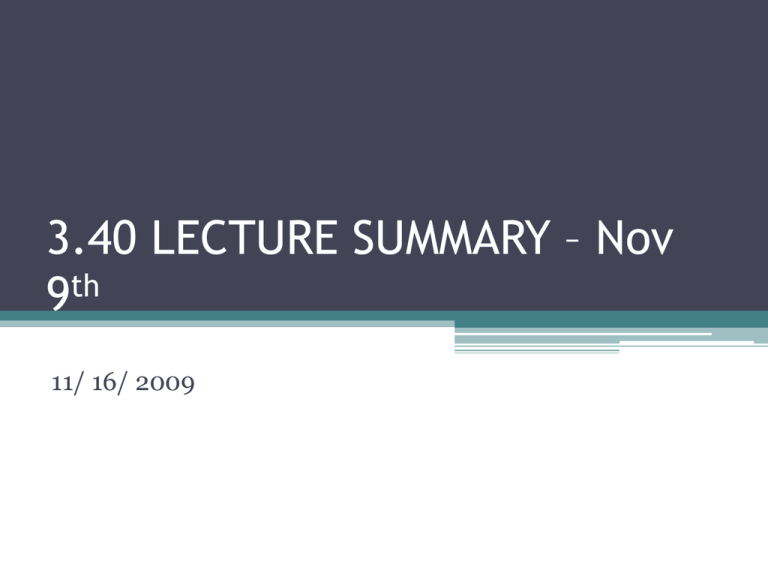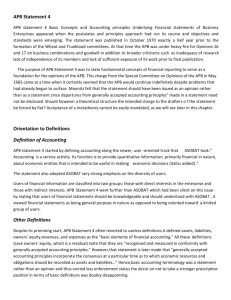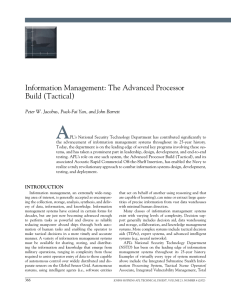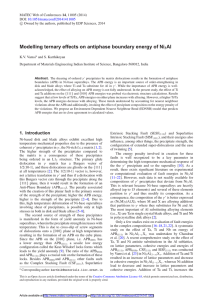3.40 LECTURE SUMMARY – Nov 9 th 11/ 16/ 2009
advertisement

3.40 LECTURE SUMMARY – Nov 9th 11/ 16/ 2009 INTRODUCTION • Precipitation Hardening ▫ It relies on changes in solid solubility with temperature to produce a second phase • Hardening Mechanisms ▫ Modulus Mismatch Changes the dislocation energy ▫ Ordered Precipitates ▫ Size Effect Cutting to Bowing Transition Coherent and Incoherent Precipitates 2 COMPONENT PHASE DIAGRAMS CL CS T AXB Y TB TA A X B Y +L A +L T B +L A X B Y +L A+A X B Y A X B Y +B A AXB Y %B B Courtesy of Lionel C. Kimerling. Used with permission. Fig. 1: System forming 2 Solid Solutions [http://en.wikipedia.org/wiki/Phase_diagram] Fig. 2: System forming an Intermetallic [http://www.substech.com/] ANTI-PHASE BOUNDARIES APB Fig. 3: Dislocation cutting through an ordered precipitate forming an APB • Additional energy is required to create an APB APB 2b APB r APB V f L 2b PRECIPITATION HARDENING • Contributions to Precipitation Hardening ▫ ▫ ▫ ▫ Anti-Phase Boundaries Interfaces Coherency Strains Modulus Effect Decreasing effect on Strength tot APB int coh mod Interface APB Fig. 4: Schematic of a sheared precipitate SIZE EFFECTS • As the size of the second phase particle increases ▫ Cutting through it becomes more difficult cutting r ▫ Dislocations tend to bow around the particle by Orowan Looping 1 bowing r ▫ Critical radius ~ 5 – 30 nm Fig. 5: Shear Strength vs. Particle Radius [http://en.wikipedia.org/wiki/Precipitation_strengthening] SIZE EFFECTS • As the size increases, coherent particles transform to incoherent precipitates • The strain energy is reduced and the strengthening effect is weakened • The critical radius for this transition ~ 10 nm – 1 mm (a) Coherent (b) Coherent with Strain (c) Semi-Coherent (d) Incoherent Fig. 6: Different types of interfaces [http://www.doitpoms.ac.uk/tlplib/solid-solutions/] Courtesy of DoITPoMS, University of Cambridge. Used with permission. PRECIPITATE FREE ZONES • Heterogeneous nucleation at grain boundaries, dislocations • Particles nucleate at grain boundaries • Regions surrounding the grain boundary are Fig. 7: PFZ near grain boundaries in Al -4 wt% Cu depleted of solutes, [http://www.msm.cam.ac.uk/phasetrans/abstracts/pfz. forming PFZs html] Courtesy of Harry Bhadeshia. Used with permission. SUMMARY • Precipitation Hardening provides a greater increase in strength than solid solution strengthening • Intermetallics are better obstacles to dislocation motion due to the creation of Anti-Phase Boundaries • 2 critical radii exist: ▫ Cutting to bowing: rc ~ 10 nm ▫ Coherent to Incoherent: rc/i ~ 10 nm – 1 mm QUESTIONS? MIT OpenCourseWare http://ocw.mit.edu 3.40J / 22.71J / 3.14 Physical Metallurgy Fall 2009 For information about citing these materials or our Terms of Use, visit: http://ocw.mit.edu/terms.






